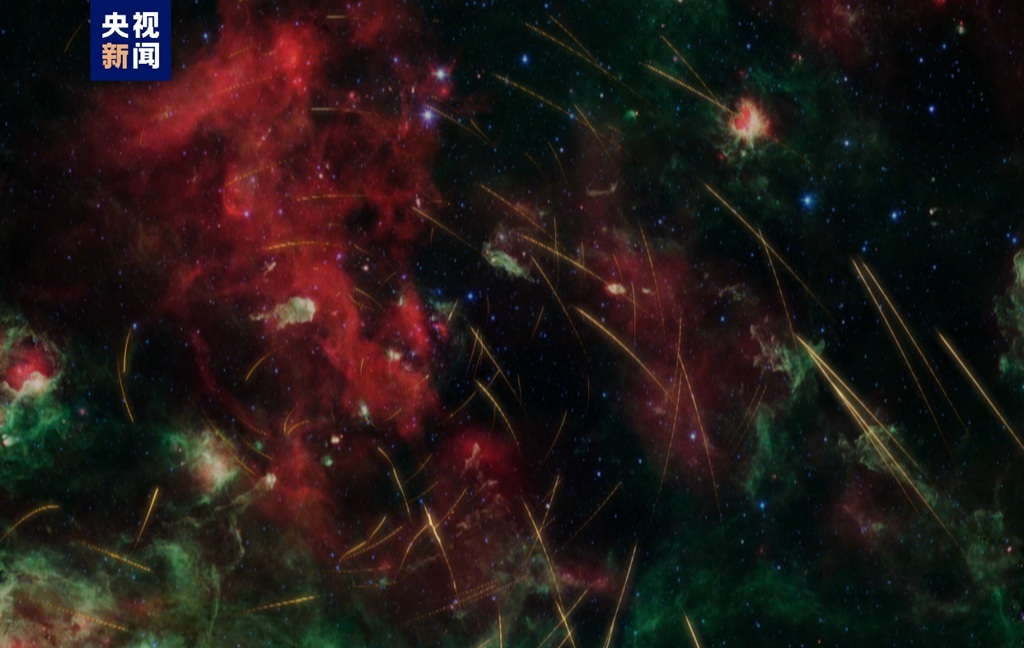
Chinese researchers have discovered a giant ultra-high-energy gamma-ray bubble structure in the Milky Way, revealing the origin of cosmic rays with energy higher than 10 Peta-Electronvolt (PeV) for the first time, according to research published in the journal Science Bulletin on Monday.
Cosmic rays are charged particles from outer space, and the origin of cosmic rays is one of the most significant frontier scientific issues in contemporary astrophysics.

Rendering of a giant ultra-high-energy gamma-ray bubble structure. /China Media Group
Researchers from the Institute of High Energy Physics of the Chinese Academy of Sciences (CAS), using the country's Large High Altitude Air Shower Observatory (LHAASO), detected the giant bubble structure in the Cygnus star-forming region.
Inside the bubble, the researchers found multiple photons with energies exceeding 1 PeV, with the highest reaching 2.5 PeV.
That indicates "the presence of a super cosmic ray accelerator inside the bubble, which continuously accelerates high-energy cosmic ray particles with energies of up to 20 PeV and injects them into interstellar space," said the researchers.

Rendering of a massive star. /China Media Group
Through their studies, the researchers identified a massive star cluster near the bubble's center, "the most promising candidate" for the super cosmic ray accelerator, which they called Cygnus OB2.
Cygnus OB2 is composed of many young, hot, massive stars with surface temperatures of about 15,000 degrees Celsius to 35,000 degrees Celsius, said the researchers. These stars' radiation luminosity is hundreds to even millions of times that of the sun, and their enormous radiation pressure can blow material from the star's surface, creating a strong stellar wind that can travel up to 3,000 kilometers per second.
The collision between stellar winds and the surrounding interstellar medium and the violent collision between stellar winds have created "ideal sites for efficient particle acceleration," the researchers said.

Rendering of ultra-high-energy cosmic rays propagation in interstellar space. /China Media Group
"This is the first super cosmic ray accelerator identified as of now," Cao Chen, chief scientist of LHAASO and academician at the CAS, told CGTN.
Cao said the finding is "simply unimaginable" without LHASSO, which has an extremely strong sensitivity that allows it to see where cosmic rays originate from and observe the behavior of cosmic ray propagation.

The Large High Altitude Air Shower Observatory in Daocheng County, southwest China's Sichuan Province. /China Media Group
Located at an altitude of 4,410 meters in Daocheng County, southwest China's Sichuan Province, LHAASO is a major national scientific and technological infrastructure focusing on cosmic ray study.
The observatory is a composite array consisting of a ground-based shower particle detector array of 5,216 electromagnetic particle detectors and 1,188 muon detectors, a 78,000-square-meter water Cherenkov detector array, and 18 wide-angle Cherenkov telescopes, featuring the most sensitive ultra-high-energy gamma-ray detection device in the world.
Last June, the observatory detected the "brightest-of-all-time" gamma-ray burst.
"In time, LHAASO is expected to detect more super cosmic ray accelerators and hopefully solve the mystery of the origin of cosmic rays in the Milky Way," said Cao. (CGTN)

86-10-68597521 (day)
86-10-68597289 (night)

52 Sanlihe Rd., Xicheng District,
Beijing, China (100864)

